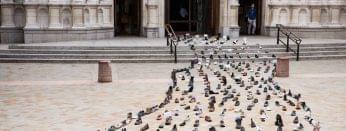On 15 August 2018, hundreds of shoes were displayed outside Westminster Cathedral to illustrate Catholic action in support of Pope Francis’s refugee campaign.
The installation of shoes is part of the Share the Journey campaign led by Catholic charities, CAFOD and Caritas Social Action Network (CSAN), which is urging world leaders and governments to take positive action to address the rights of refugees through an ambitious United Nations Global Compact to be signed on 18 September 2018.
Over 40,000 CAFOD and CSAN supporters have been inspired by Pope Francis’ message to welcome the stranger. In solidarity with people on the move, they have walked the equivalent of over four times the distance around the world (100,000 miles).
The campaign is in response to Pope Francis’s call for world leaders to agree two UN ‘Global Compacts’ on how to assist refugees and migrants, most of whom live in poverty in poor countries. The shoe display took place ahead of next month’s UN General Assembly in New York at which the first of these compacts – focused on refugees – will be presented. The Share the Journey campaign focuses on five points for world leaders to include in the global agreements:
- To protect the dignity of people on the move because of war, persecution, human rights abuses, poverty, and natural disaster
- To ensure special protection for the most vulnerable people
- To ensure sufficient support to countries hosting refugees
- To support family integrity through facilitating family reunification
- To tackle root causes of forced displacement
Phil Kerton, co-director of CSAN member “Seeking Sanctuary” sourced from refugees around 300 of the shoes used in the installation. He is a frequent visitor to Calais, delivering donated goods or cash to one or another of the groups that provide support to the exiles stuck in and around the town. Early in 2018, he arranged for people to collect discarded clothes for an impressive and thought-provoking art installation that was suspended in the nave of Canterbury Cathedral during Lent and Eastertide. As a consequence, he says, he has acquired a reputation as fixer who can arrange for such items to be acquired. Old footwear was just another small challenge!
Trainers and other footwear are constantly in demand from people who have ended up at Calais in the hope of crossing to the UK. Phil reports that local police confiscate property several times a week and render it useless, dousing bedding with pepper spray, battering phones and cookware with batons and – in particular – slicing into one of a pair of shoes with sharp knives, rendering the remaining shoe pointless. This explains why so many “lone” items are discarded.
Enquiries at the “Help Refugees” warehouse, where donated goods are stored for distribution, revealed that, although shoes are not consistently brought back when swapped, a quantity of worn footwear was lying around. Phil Kerton was welcome to pick it up when he next visited. In fact, as it turned out, he was given a 1m3 bag full of items that would otherwise have headed to the council’s refuse incinerator – for a fee. This formed the core of the Westminster Cathedral installation.
Picture credit: CAFOD





